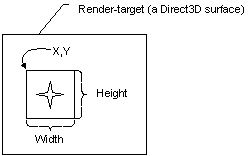Viewport Rectangle
You define the viewport rectangle in C++ by using the D3DVIEWPORT9 structure. The D3DVIEWPORT9 structure is used with the following viewport manipulation methods exposed by the IDirect3DDevice9 interface.
The D3DVIEWPORT9 structure contains four members?B>X, Y, Width, and Height—that define the area of the render-target surface into which a scene will be rendered. These values correspond to the destination rectangle, or viewport rectangle, as shown in the following illustration.

The values you specify for the X, Y, Width, and Height members of the D3DVIEWPORT9 structure are screen coordinates relative to the upper-left corner of the render-target surface. The structure defines two additional members (MinZ and MaxZ) that indicate the depth-ranges into which the scene will be rendered.
Microsoft?Direct3D?assumes that the viewport clipping volume ranges from -1.0 to 1.0 in X, and from 1.0 to -1.0 in Y. These were the settings used most often by applications in the past. During the projection transformation, you can adjust for viewport aspect ratio before clipping. This task is covered by topics in Projection Transformation section.